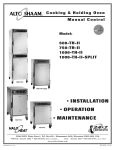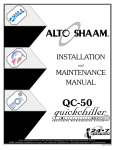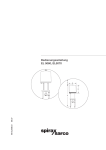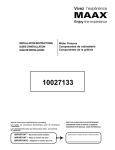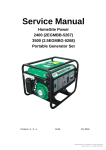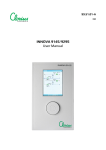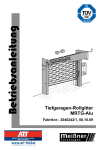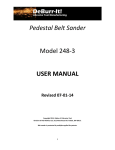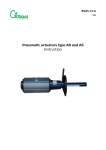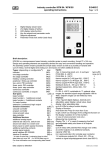Download 99.48.06 - Clorius Controls
Transcript
99.48.06-C GB Electric Valve Actuator type MT90 Marine for 3-way valves User Guide Contents Hint. Reservation of the right of modification and proprietary right................................................................................................3 Safety information and warning.....................................................................................................................................................4 Transport and storage, warranty, safety symbols..........................................................................................................................5 1. Technical description....................................................................................................................................................................6 1.1 Range of application................................................................................................................................................................6 1.2 Design......................................................................................................................................................................................6 1.3 Mode of operation....................................................................................................................................................................6 1.4 Technical data for 1.2 kN resp. 2 kN........................................................................................................................................7 1.5 Dimensions..............................................................................................................................................................................8 2. Mounting........................................................................................................................................................................................9 2.1 Installation conditions and mounting position..........................................................................................................................9 2.2 Manual operation of the linear actuator...................................................................................................................................9 2.3 Combination of the linear actuator with a valve.....................................................................................................................10 2.4 Reassembling the adjusting lever resp. the contact piece..................................................................................................... 11 3. Electric connection – safety prescriptions...............................................................................................................................12 3.1 Lifting the hood off.................................................................................................................................................................12 3.2 Making the electric connection..............................................................................................................................................12 3.3 Connection example 1...........................................................................................................................................................13 3.3.1 Test run of the actuator...............................................................................................................................................13 3.4 Connection example 2...........................................................................................................................................................14 3.4.1 Test run of the actuator...............................................................................................................................................14 3.5 Connection example 3...........................................................................................................................................................15 3.5.1 Test run of the actuator...............................................................................................................................................15 3.6 After electric connection and test run effected.......................................................................................................................16 3.7 Operation with three-phase alternating current.....................................................................................................................16 4. Travel dependent end position switches “ WE” S3 and “ WE” S6.........................................................................................18 4.1 Adjustment of the travel dependent switch S3.......................................................................................................................18 4.2 Adjustment of the travel dependent switch S6.......................................................................................................................19 4.3 Retrofit of the travel dependent switches S3 and S6.............................................................................................................19 5. Switching and signalling device................................................................................................................................................20 5.1 Assembly and adjustment of the switching and signalling device..........................................................................................21 5.1.1 Adjustment of a different positioning travel.................................................................................................................21 5.1.2 Adjustment of the potentiometers...............................................................................................................................22 5.1.3 Adjustment of the travel switch S4 in direction “ingoing driving rod” into the actuator................................................22 6. Retrofit of the switching and signalling device........................................................................................................................23 7. Retrofit of travel switches S4 and S5........................................................................................................................................24 8. Retrofit of potentiometer R1 resp. R2........................................................................................................................................25 8.1 Adjustment of the potentiometers..........................................................................................................................................25 8.2 Additional force dependent switches “DE” S7 and S8...........................................................................................................25 9. Heating.........................................................................................................................................................................................26 9.1 Retrofit of the heating resistor................................................................................................................................................26 11. Maintenance...............................................................................................................................................................................27 12. Repair.........................................................................................................................................................................................27 13. Spare parts.................................................................................................................................................................................28 14. Type signation...........................................................................................................................................................................29 15. Position regulator PEL (option)...............................................................................................................................................30 15. Functionality and functions of the position regulator..............................................................................................................30 15.2 Assembly of the position regulator.......................................................................................................................................31 15.3 Electrical connection............................................................................................................................................................31 15.3.1 Configuration of terminals.........................................................................................................................................31 15.3.2 Determining the input and output signal...................................................................................................................32 15.4 Commissioning and settings................................................................................................................................................33 15.4.1 Electric adjustment to the positioning travel.............................................................................................................34 15.4.2 Setting the dead zone...............................................................................................................................................34 15.4.3 Reversing..................................................................................................................................................................34 15.4.4 Wire break detection.................................................................................................................................................34 15.4.5 Split range operation.................................................................................................................................................35 15.4.6 Modification of the preset setpoint signal range.......................................................................................................35 15.5 Technical data......................................................................................................................................................................36 15.5.1 Wiring examples.......................................................................................................................................................36 Electric Valve Actuator type MT90 Marine 2 Clorius Controls A/S Hint...................................................................................... For reasons of clearness the operating instructions cannot include all detailed information to all types of the product and thus cannot take into consideration every thinkable case of installation, application, operation or up-keep. In case of doubt, the German text shall be applicable (available on request). With a posterior equipment of the actuator with other than original parts, respectively retrofits without being known by the manufacturer of the actuator the CE certification of the actuator as well as any liability of the manufacturer of the actuator lose their validity for this actuator. If you desire more detailed information or if any special problems should arise, which have not been described sufficiently in these instructions, please ask the supplier of the actuator resp. valve for the required information. We point out furthermore that the contents of these operating instructions is not part of a former or of an existing agreement, a promise or of a legal relationship nor is to alter it. All obligations on the part of the manufacturer of the actuator result from the respective purchase contract respectively the terms and conditions containing the complete and solely valid warranty regulations. The contractual warranty terms are neither extended nor limited by the statements of the operating instructions. Reservation of the right of modification and proprietary right...................... The prescriptions, directives, standards etc. mentioned in these operating instructions conform to the state of information during the time of the elaboration of these operating instructions and are not subject to any alteration service. They are to be applied by the operator in own responsibility each time in their latest, valid version. The right to making technical changes and improvements at any time is kept reserved with regard to all data, indications, hints and depictions in these instructions. Any claim to changing and subsequently improving appliances that have already been delivered remains excluded. The copyright concerning these operating instructions and also all rights in case of a grant of patent or a registration of utility model remain with the manufacturer of the actuator. Operating instructions linear actuator “SBA 12 – SBA 20 – SBA 45” Electric Valve Actuator type MT90 Marine 3 3 of 29 Clorius page Controls A/S Safety information.............................................................. The linear actuator here described is an electric appliance: it is part of a power plant for industrial application it is laid out in accordance with the generally acknowledged rules of engineering Electrical equipment can – owing to circumstances – cause severest injury to health or material damages because of inappropriate application false operation improper electrical connection inappropriate assembly onto a control element non-observance of ambient and operating conditions inadmissible intervention inadmissible removal of an existing coverage inappropriate transportation inappropriate storage Warning............................................................................... Mount and operate this appliance only, if previously qualified personnel has provided that appropriate power supplies are utilised assuring that during normal operation or in case of plant or plant parts failure no dangerous voltages can reach the appliance. If you do not observe this warning, there can occur death, severe body injuries or essential material damages. Pay attention to moving parts during the mounting and adjustment. There exists the danger of being injured and the risk of essential material damages. Those persons who are responsible for the safety of the installation must therefore grant that only qualified persons are charged with the works on this appliance these persons have read and understood the operating instructions and product information attached (we recommend our customers to have this confirmed by the mounting personnel in writing) the operating instructions are constantly available and the respective persons are obliged to consistently observe them with all their works (before starting to carry out any works guided by the operating instructions, there should eventually existing complementary instructions and documents about valves and control elements of these instructions be attached) with corresponding works a workman-like application of tools, measuring instruments and, if necessary, the use of personal protective equipments is effected works on this appliance or in its vicinity are interdicted to not qualified personnel Qualified personnel are persons who are familiar with the set-up, mounting, commissioning and operation of the product and dispose of the respective qualification with regard to their activity, p.e. training or instruction respectively authorisation to switch on and off power circuits and appliances/systems according to the standards of safety technology and to release, earth and mark these training or instruction according to the standards of safety technology in the attendance and use of adequate safety equipment schooling in first aid Operating instructions linear actuator “SBA 12 – SBA 20 – SBA 45” Electric Valve Actuator type MT90 Marine 4 4 of 29 Clorius page Controls A/S Transport and Storage....................................................... Concerning transport and storage of the linear actuator the following is to be observed: The transport to the place of installation must be effected in a firm packing If the linear actuator is built on valve, the hoist must not be fixed on the actuator Store the actuator in a well aerated and dry room Protect the actuator against humidity of the soil by storing it in a shelf or on a wooden grid Fix a sheathing to protect against dust and filth etc. Warranty.............................................................................. No warranty is accepted for damages, which have arisen due to: non-observance of the operating instructions inappropriate or inexpert utilisation defective mounting respectively commissioning through the buyer or third parties natural wear defective or negligent handling chemical or electrochemical influences, inasmuch these must not be attributed to a fault of the manufacturer improper changes respectively repair works made by the buyer or third parties action by parts of foreign origin Explanation of the safety symbols and notions.............. This sign means: DANGER! In case of non-observance lethal danger can exist respectively severe physical injuries and/or essential material damages can occur. This sign means: HINT! The hint marks technical relationships, to which it is especially pointed out. In case of non-observance there can occur deficient functions, operating disturbances and perhaps consequential damages. This sign means: INFORMATION! This sign gives necessary information about details that have to be observed. In case of non-observance deficient functions can occur. Operating instructions linear actuator “SBA 12 – SBA 20 – SBA 45” Electric Valve Actuator type MT90 Marine 5 5 of 29 Clorius page Controls A/S 1. Technical description 1.1 Range of application These linear actuators actuate control elements requiring a linear positioning motion of 16–75 mm and a positioning force in the range of 1.2 kN and 2–6 kN, p.e. control valves cut-off valves lock-up valves The actuators are set to the desired tripping force the desired positioning travel They can be adjusted to another positioning travel later-on. 1.2 Design The linear actuators are laid out for maximum thrust. The electrical components are incorporated under the hood – separate from the gearing. They are thus protected from perhaps harmful operating conditions perhaps harmful environmental conditions humidity dust All components are easily accessible after removal of the hood. To the basic equipment there belong 2 force dependent switches (“S1” and “S2”). They switch the motor off, if a correspondingly strong force is counteracting the tripping force adjusted in the actuator, which is generated p.e. by the resting of the flow restrictor on the seat of the control element. They switch off the motor also in case that the flow restrictor encounters solid bodies having penetrated into the control element and thereby protect the control element from a more severe damaging and the actuator from overloading. Additionally there can be built in 1 or 2 travel dependent switches (“S3” and “S6”). They limit the positioning travel in open resp. closed position and are mounted on the existing DE-switch mounting angle. 1 or 2 travel dependent switches (“S4” and “S5”). They limit the end positions or indicate intermediate or end positions and are mounted onto the switching and signalling device. 1 or 2 force dependent switches (“S7” and “S8”) with – vis-à-vis “S1” and “S2” – an anticipatory (leading) tripping point 1 or 2 potentiometers. These are mounted to the switching and signalling device. 1 electronic positioner “PEL” (electronic position regulator) for analog triggering 0 (2) ... 10 V respectively 0 (4) ... 20 mA 1 heating resistor, which avoids the formation of condensation water under the hood with strongly oscillating ambient temperatures and with high air humidity 1.3 Mode of operation The rotational motion of the motor in the linear actuator is transmitted via a spur gearing onto the centre gear with internal screw thread. It is in this internal screw thread that the driving rod is running provided with external thread. This driving rod is safeguarded against torsion via an anti-rotation assembly adjacent to the yoke. The driving rod executes a linear draw or thrust motion, when the centre gear with the internal screw gear is turned via the motor gearing. The anti-rotation assembly serves at the same time as a stroke indication. The linear actuator can also be screwed via flange mounting F05 directly onto a valve with a cast yoke from customer's side. The driving rod of the actuator must then be safeguarded against torsion. Operating instructions linear actuator “SBA 12 – SBA 20 – SBA 45” Electric Valve Actuator type MT90 Marine 6 6 of 29 Clorius page Controls A/S 1.4 Technical data for 1.2 kN resp. 2 kN Type: Type Tripping force: Tripping force MT90SBA 12 or SBA 20 1.2 kN or 2 kN 1.2 kN Travel/stroke: 16upmm upmm to 75 mm Travel/stroke 16 mm to 75 Manual adjustment: with handwheel at side Manual adjustment with handwheel at side Permissible ambient temperature: –20 °C up to +60 °C Permissible ambient temperature –20 °C up to +60 °C Mounting position: any, except with the actuator hanging downwards Mounting position any, except with the actuator hanging downwards Degree of protection (DIN 40050): IP 65 Degree of protection (DIN 40050) IP 65 Mounting A: yoke with anti-rotation flange for driving rod and Mounting A yoke –with anti-rotation flangecoupling for driving flange rod and if required – with – if required – with coupling flange Mounting B: flange mounting acc. to DIN 3358 – F05, Mounting B flange mounting to DIN – F05, against torsion driving rodacc. must be3358 protected driving rod must be protected against torsion 1~50 Hz/230 V; (1~50/60 Hz/24 V, 1~60 Hz/110 V, Power supply: Power supply 1~503~50 Hz/230Hz/400 V; (1~50/60 V, 1~60 Hz/110 V V) –Hz/24 different voltage on request – – different voltage on request – via internal terminal strip with 2 screwed glands M16 x 1.5 and Electric connection: Electric connection via internal terminal strip with 2 screwed glands M16 x 1.5 and 1 dummy plug M16 x 1.5 or 1 dummy plug M16 x 1.5 or compact plug 10+24-poles compact plug 10+24-poles Operating mode (VDE 0530): S1 – 100% c.d.f. or S4 – 30% c.d.f. – 600 c/h Operating mode (VDE 0530) S1 – 100% c.d.f. or S4 – 30% c.d.f. – 600 c/h End switching: 2 (max. 4) force dependent switches “DE”, max. 250 V AC End switching 2 (max. 4) force dependent switches “DE”, max. 250 V AC 1 (max. 2) travel dependent signal switches “WE” for ingoing 1 (max. 2) travel dependent signal switches “WE” for ingoing or outgoing driving rod (optional) or outgoing driving rod (optional) for ohmic load, for ohmic load, max. 5 Amax. 5 A for inductive load, max. 3 A max. 3 A for inductive load, for signal lights, max. 1 Amax. 1 A for signal lights, Lubricant for Klüber Microlube GL 261 GL 261 Lubricant for gearing gearing: Klüber Microlube Positioning speed mm/min 25 (with 1.2 kN) Positioning speed: mm/min Operating voltage/frequency Operating voltage/frequency: Rated voltage V Rated voltage: V Rated current mA Rated current: mA 25 (with 1.2 kN) resp. 15 (with 2 kN) 3-phase AC 50 Hz 1-phase AC 50 Hz 3-phase AC 50 Hz 24 230 400 24 230 400 275 29 15 275 29 15 Power consumption: Power output Power output: Rotation speed Rotation speed: 6.6 2.4 2.4 500 500 Power consumption W W W W rpm rpm 1-phase AC 50 Hz 6.6 6.6 6.6 2.4 2.4 500 500 9.9 9.9 3.1 500 500 3.1 – different positioningspeed, speed,voltage voltage or request – – – different positioning or frequency frequencyonon request Additional equipment Additional equipment: 1 electronic positioner for analog triggering 0 (2) ... 10 Vassembly) 1 switching and“PEL” signalling unit (teletransmitter 1 (max. 2) travel signal switches “WE”, max. 250 V AC 1 (max. 2)dependent travel dependent signal switches “WE”, for ohmic load, max. 5 Amax. 5 A for ohmic load, for inductive load, max. 3 A for inductive load, max. 3 A for signal lights, max. 1 A max. 250 V AC for signal lights, max. 1 A 1 (max. 2) potentiometers 100 Ω, 200 Ω, 500 Ω, 1 kΩ, 2 kΩ, 5 kΩ or 10 kΩ . 1 (max. 2) potentiometers 100 � , 200 � , 500 � , 1 k� , 2 k� , – further ohmic values on request – k� 10 current k� . – max. further max. 51.5 W,or wiper 30ohmic mA values on request – max. 1.5 W, wiper current max. 30 mA resp. 1 electronic position transmitter “ESR” 24 V DC, resp. position transmitter “ESR” output 0 (4) 1 ...electronic 20 mA (requires enlargened cover and hood)24 V DC, output 0 (4) ... 20 mA (requires enlargened cover and hood) 1 heating resistor 24/110/230 V DC/AC, 15 W 1 heating resistor 24/110/230 V DC/AC, 15 W 1 electronic positioner “PEL” for analog triggering 0 (2) ... 10 V 1 electronic positioner “PEL”feedback for analog triggering 0 (2) ... 10 V resp. 0 (4) ... 20 mA; equi-directional included resp. 0 (4) ... 20 mA; equi-directional feedback included Operating instructions linear actuator “SBA 12 – SBA 20 – SBA 45” Electric Valve Actuator type MT90 Marine 7 7 of 29 Clorius page Controls A/S 1.5 Dimensions Figure 1.5: Dimensions for actuator MT90 Figure 1.5: Dimensions for actuator SBA 12 – SBA 20 – SBA 45 Operating instructions linear actuator “SBA 12 – SBA 20 – SBA 45” Electric Valve Actuator type MT90 Marine 8 9 of 29 Clorius page Controls A/S 2. Mounting 2.1 Installation conditions and mounting position The mounting spot for the linear actuator must be chosen in a way that the actuator is easily accessible sufficient free space is available for taking the hood off, resp. in order to carry out adjusting works the linear actuator will be protected against strong heat radiation the environmental temperature will not be more than +60 °C In open air the linear actuator must be protected with an additional coverage against rain direct insolation strong draught air dust influence In case of strongly oscillating ambient temperatures and high air humidity the installation of a heating resistor is recommendable in order to minimize the formation of condensate in the actuator. Actuator coverages with suppressed cold bridges (double hoods) are recommended. In the open, respectively an environment having high pollutant concentrations, e.g. areas having a high traffic rate, industrial areas (chemical plants, sewage works, etc.) coastal regions and open sea, the actuators must additionally be provided with external blinds of non-corrosive material and also with a special lacquering. The installation position is arbitrary, however not overhead. In case of an installation position with horizontally situated driving rod the linear actuator is mounted in a way that both columns of the yoke are situated in a vertical level one above the other. Figure 2.1: Assembly of the actuator with yoke with horizontally situated driving rod 2.2 Manual operation of the linear actuator The manual adjustment must not be disengaged or engaged while the motor is running. Execute the manual adjustment only with motor being at standstill; hereto With the left hand press the disengaging rod with plate in direction of the outgoing driving rod toward the bottom Simultaneously turn the handwheel with the right hand until the coupling-in has sensibly been executed To actuate the linear actuator now turn the handwheel; hold the disengaging rod with the plate in engaged position Turn crank handle to the right (clockwise) � driving rod moves out of the actuator Turn crank handle to the left (anti-clockwise) � driving rod moves into the actuator The linear actuator is automatically switched back to motoric operation, as soon as the disengaging rod will be released. Figure 2.2: Manual actuation of the linear actuator Operating instructions linear actuator “SBA 12 – SBA 20 – SBA 45” Electric Valve Actuator type MT90 Marine 9 10 ofA/S 29 Clorius page Controls 2.3 Combination of the linear actuator with a valve Before making the assembly check whether the technical data of the linear actuator conform to the conditions of application the valve is complete (tie-bar at actuator or valve) the thread of the valve stem conforms with the threaded bush of the linear actuator the linear actuator is complete with the tie-bar or yoke columns and coupling parts for the assembly with the provided valve the perhaps required additions in the actuator have already been built in the to-be-connected operating voltage conforms to the voltage of the actuator the indications on the name plate conform with the indications given on the motor the adjusted or still to-be-adjusted stroke of the actuator conforms with the stroke of the valve In the state of delivery the driving rod of the actuator is moved out until the lower final position. Further procedure (see figure 2.3): Insert valve stem into the valve all the way to limit stop Move driving rod of the linear actuator into threaded bush by turning the handwheel anti-clockwise by about 20 mm or by at least the screw-in depth of the valve stem Turn counter nut onto the valve stem until run-out of thread Untighten and screw out both hexagon socket screws [66], with which the locking plate [61] has been screwed down Lay the locking plate [61] over the valve spindle Lift the actuator over the valve stem and put it onto the upper valve part Fix the actuator loosely with impact nut or fixing screw/fastening nut When mounting pay attention that the flow restrictor in the valve or control element is not pressed onto the seat and is not turned (what could be caused by the tightening of the impact nut or of the fixing screw/fastening nut), what would lead to damaging the control element and perhaps the actuator. Slide valve stem against threaded bush [59] and simultaneously turn threaded bush [59], until the thread of the valve stem will reach the screw-in depth (screw-in depth max. 25 mm) Push locking plate [61] over threaded bush [59] If necessary, turn threaded bush [59] slightly, so that the locking plate will be congruent with the fixing holes in the coupling flange [58] Screw in both hexagon socket screws [66] and tighten them Turn counter nut against threaded bush [59] and counterfasten it Tighten impact nut or fixing screws/fastening nuts Mount the linear actuator accordingly to other control elements, p.e. regulating flaps with mounting yoke. Figure 2.3: Coupling/mounting the actuator onto a valve Operating instructions linear actuator “SBA 12 – SBA 20 – SBA 45” Electric Valve Actuator type MT90 Marine 10 11 ofA/S 29 Clorius page Controls If a greater change of the required end position of the moved-out thrust rod is required because of problems of the adaptation resp. if a switching and signalling device [114] (see figure 5-1) has been built into the actuator, remove the adjusting lever [260] resp. the contact piece [37] (see figure 2.5-1) for WE-switch S3 by untightening the nuts [287] (see figure 2.5-2) from the lug of the thread of the driving rod, if necessary. 2.4 Reassembling the adjusting lever resp. the contact piece see chapter 5 “switching and signalling device”. 2.5 Add-on of linear actuator according to DIN 3358 – F05 onto control elements with cast yoke or onto adjusting flaps with mounting yoke Delivery state of the actuator: Without yoke columns Without anti-torsion assembly of the driving rod in the actuator Centring diameter on the housing and 4 fastening bores M6 acc. to DIN 3358 – F05 Driving rod moved out until lower end position Driving rod with or without coupling parts (customer-specific) With built-in switching and signalling device [114] (see figure 5-1) the adjusting lever [260] with slider [261], nuts [287] and toothed discs [290] are loosely attached to the actuator (because of the danger that these parts could be damaged they are not mounted onto the lug of the thread of the driving rod) Mounting of these parts see chapter 5.1 resp. chapter 10.12. Carry out the mounting procedure as follows: Move driving rod of the actuator to stroke middle into the actuator by manual adjustment (see chapter 2.2) Mount linear actuator onto control element Couple driving rod of the actuator to spindle of the control element and safeguard driving rod against torsion Concerning coupling parts, which do not originate from the manufacturer of the actuator, pay attention that no offset occurs between the driving rod of the actuator and the spindle of the control element. Otherwise this would lead to a loss of performance between the threaded nut and the driving rod and perhaps to a blocking of the threaded nut. 266 288 282 273 S4 S5 281 278 272 260 261 287 290 252 283 291 253 275 Figure 2.5-1: Position of the parts in the actuator Operating instructions linear actuator “SBA 12 – SBA 20 – SBA 45” Electric Valve Actuator type MT90 Marine Figure 2.5-2: Switching and signalling device with pot. and WE-switches S4 and S5 11 12 ofA/S 29 Clorius page Controls 3. Electric connection – safety prescriptions Mains connection and commissioning of this linear actuator require special know-how about the erection of power installations (DIN VDE 0100), the knowledge of accident prevention and of the special commissioning conditions of this linear actuator. These works must only be carried out by qualified personnel. In case of non-observance of this warning there can death, severe physical injuries or essential material damages be the outcome! Observe the safety information on page 4 of these operating instructions! Carry out mains connection only with power supply switched off! Safeguard against unintentional switching on! For installing electric lines and the mains connection the DIN/VDE regulations for the installation of power systems and equipment, as well as the provisions of the local Electricity Board must be observed! Check the mains connection voltage and frequency for conformity on the name plate of the linear actuator and also the name plate of the driving motor. The conductor cross section must always be laid out according to the respective power consumption of the linear actuator and the required length of the line. Too small conductor cross sections are a frequent cause for supposed “operating disturbances”! Minimum cross section of the conductor for this type of linear actuator: 1 mm². Mains fuse protection concerning the installation: max. 6 A. Disconnection from mains supply concerning the installation: for the separation and voltage release of the mains lead to the actuator for maintenance and adjustment works a respective breaker unit must be utilised granting an all-pole separation (except the earth lead). This breaker unit must be lockable in the state of breaking and be safeguarded against unintentional switch-on. 3.1 Lifting the hood off In case of maintenance and adjustment works switch the supply line to dead state first! Screw off cap nut Take off gasket Embrace the hood on the cover and pull it off under slight pressure 3.2 Making the electric connection On principle the wiring diagram glued into the hood is applicable. Move the previously mounted actuator by means of manual adjustment (see chapter 2.2) to approximate stroke middle Remove the blanking plate in the existing screwed cable gland Slide the supply line through the screwed cable gland until enough length of line exists to the corresponding supply terminals Strip the line wrapping about 1 cm above the screwed cable gland Strip the individual cores at a distance of about 5 mm from the end Concerning the cores of stranded wires the end sleeves are to be slided onto the stripped end and be crimped Guide and fasten the lines in the actuator in a way that they are protected from moving or rotating parts and are not damaged when taking the hood off or putting it back Operating instructions linear actuator “SBA 12 – SBA 20 – SBA 45” Electric Valve Actuator type MT90 Marine 12 13 ofA/S 29 Clorius page Controls 3.3 Connection example 1 Operation with single-phase alternating current (three-step triggering) Final switch-off: driving rod moving in/out load-dependently via force dependent “DE”-switches S1 and S2 Figure 3.3: Wiring diagram If the actuator is driven by only 2 force dependent switches DE – S1 and DE – S2, attention must be paid that the control element (valve) can be driven also on load on both sides. Observe the documentation concerning the control element! Connect the actuator as follows: Connect earthed conductor of the supply line (core green/yellow) onto provided safety earth terminal Connect zero conductor N of the supply line to terminal 1 Connect control cable for outgoing driving rod to terminal 11 Connect control cable for ingoing driving rod to terminal 14 Set in bridges; from terminal 10 to terminal 3 and from terminal 13 to terminal 2 3.3.1 Test run of the actuator DANGER !!! The linear actuator without hood may be short-term-operated only during test run respectively for indispensible adjusting works on electrical options such as p.e. potentiometer, travel switch or electronic positioner. During this activity there exists access to dangerous live, blank, moving and rotating parts. In case of inappropriate or uncautious execution of the adjusting works there can death, severe physical injuries or essential material damages be the outcome. Only qualified personnel (see page 4) is allowed to carry out this activity. The operation of the linear actuator without hood is interdicted for a purpose different to what has been described as mentioned before. Trigger the actuator via a three-step controller: N to terminal 1 and L to terminal 11 � driving rod moves out of the actuator N to terminal 1 and L to terminal 14 � driving rod moves into the actuator Actuate the switching rollers of the switches with an insulated screwdriver and check, whether the respective switches switch off the motor: Outgoing driving rod � upper DE-switch S1 Ingoing driving rod � lower DE-switch S2 If necessary, interchange the inset motor feed bridges on terminals 2 and 3 S1 S2 Figure 3.3.1: DE-switches S1 and S2 Operating instructions linear actuator “SBA 12 – SBA 20 – SBA 45” Electric Valve Actuator type MT90 Marine 13 14 ofA/S 29 Clorius page Controls 3.4 Connection example 2 (only possible with travel dependent switch S3 incorporated in the actuator on the DE-mounting angle). Operation with single-phase alternating current (three-step triggering) Final switch-off of driving rod moving out of the actuator load-dependently via force dependent DE-switch S1 Final switch-off of driving rod moving into the actuator load-dependently via DE-switch S2 connected in series with WE-switch S3 (mounted to DE-mounting angle) Figure 3.4: Wiring diagram Connect the actuator as follows: Connect earthed conductor of the supply line (core green/yellow) to provided safety earth terminal Connect zero conductor N to terminal 1 Connect control cable for outgoing driving rod to terminal 11 Connect control cable for ingoing driving rod to terminal 14 Inset bridges; from terminal 10 to terminal 3, from terminal 16 to terminal 2 and from terminal 13 to terminal 17 Adjust positioning travel by shifting the travel dependent switch S3 (see chapter 4) 3.4.1 Test run of the actuator Trigger actuator via three-step controller: N to terminal 1 and L to terminal 11 � driving rod moves out of the actuator N to terminal 1 and L to terminal 14 � driving rod moves into the actuator Actuate the switching rollers of the DE-switches S1–S2 and the roller lever of WE-switch S3 with an insulated screw driver and check, whether the corresponding switches actually switch off the motor: Outgoing driving rod � upper DE-switch S1 Ingoing driving rod � lower DE-switch S2 and WE-switch S3 (mounted to DE-mounting angle) If necessary, interchange the inset motor feed bridges on terminals 2 and 3 S3 Observe danger hint of chapter 3.3.1. S1 S2 Figure 3.4.1: DE-switches S1–S2, WE-switch S3 Operating instructions linear actuator “SBA 12 – SBA 20 – SBA 45” Electric Valve Actuator type MT90 Marine 14 15 ofA/S 29 Clorius page Controls 3.5 Connection example 3 (only possible with switching and signalling device with travel switch “WE” S4 incorporated in the actuator). Operation with single-phase alternating current (three-step triggering) Final switch-off of driving rod moving out of the actuator load-dependently via force dependent DE-switch S1 Final switch-off of driving rod moving into the actuator load-dependently via DE-switch S2 connected in series with WE-switch S4 (mounted to switching and signalling device) Figure 3.5: Wiring diagram Connect the actuator as follows: Connect earthed conductor of the supply line (core green/yellow) to provided safety earth terminal Connect zero conductor N to terminal 1 Connect control cable for outgoing driving rod to terminal 11 Connect control cable for ingoing driving rod to terminal 14 Inset bridges; from terminal 10 to terminal 3, from terminal 19 to terminal 2 and from terminal 13 to terminal 20 Adjust positioning travel with slider [261] on adjusting lever [260] (see chapter 5.1.1) Adjust tripping cams for travel switch S4 on switching and signalling device [114] (see chapter 5.1.3) 3.5.1 Test run of the actuator Observe danger hint of chapter 3.3.1. Trigger actuator via three-step controller: N to terminal 1 and L to terminal 11 � driving rod moves out of the actuator N to terminal 1 and L to terminal 14 � driving rod moves into the actuator Actuate the switching rollers of the DE-switches S1–S2 and the switch roller of WE-switch S4 with an insulated screw driver and check whether the corresponding switches actually switch off the motor: Outgoing driving rod � upper DE-switch S1 Ingoing driving rod � lower DE-switch S2 and WE-switch S4 (mounted to switching and signalling device) If necessary, interchange the inset motor feed bridges on terminals 2 and 3 Figure 3.5.1: DE-switches S1–S2 and WE-switches S4–S5 Operating instructions linear actuator “SBA 12 – SBA 20 – SBA 45” Electric Valve Actuator type MT90 Marine 15 16 ofA/S 29 Clorius page Controls 3.6 After electric connection and test run effected Set on hood cautiously, the hood must rest evenly on the housing rim; if necessary, correct hood position on the actuator by slight turning Lay gasket over the lug of the thread of the hood fixing bolt Screw on and tighten cap nut 3.7 Operation with three-phase alternating current This actuator can be equipped with a three-phase alternating current motor. The electrical connection is effected via an external, mechanically and electrically locked contactor-type reversing starter combination. The motor feed bridges to terminals 2 and 3 are not applicable (see wiring diagram). The rotation direction check is made by actuating the switches with an insulated screw driver (see also chapter 3.3.1, 3.4.1 and 3.5.1). If necessary the motor connections must be exchanged on terminals 2 and 3. Figure 3.7-1: Wiring diagram – on both sides force dependent disconnection Figure 3.7-2: Wiring diagram – outgoing force dependent, ingoing force and travel dependent disconnection via S3 Operating instructions linear actuator “SBA 12 – SBA 20 – SBA 45” Electric Valve Actuator type MT90 Marine 16 17 ofA/S 29 Clorius page Controls Figure 3.7-3: Wiring diagram – outgoing force dependent, ingoing force and travel dependent disconnection via S4 Operating instructions linear actuator “SBA 12 – SBA 20 – SBA 45” Electric Valve Actuator type MT90 Marine 17 18 ofA/S 29 Clorius page Controls 4. Travel dependent end position switches “ WE” S3 and “ WE” S6 With this actuator on DE-mounting angle [36] 2 travel dependent switches S3 [124] and S6 [125] can be built in. These can switch off the actuator in the end positions travel dependently, e.g. if the control element is not to be moved onto its limit stop or if the switching and signalling device [114] (see figure 5-1) has not been built in, resp. if the WE-switches S4 and S5 [282] are occupied for other purposes. The WE-switches S3 [124] and S6 [125] are actuated via a contact piece [37], which is screwed down on the threaded lug of the driving rod. WE-switch S3 � for end position moved-in driving rod WE-switch S6 � for end position moved-out driving rod Figure 4: Position of WE-switches 4.1 Adjustment of the travel dependent switch S3 Move driving rod into end position “moved-in driving rod” by manual adjustment (see chapter 2.2) Untighten cheese head screws [48] a little from the rear side of the DE-mounting angle [36] WE-switch S3 [124] for limiting the positioning travel in direction of “ingoing driving rod” (going into the actuator) must at first be above contact piece [37]; if necessary push the switch up. Push switch S3 [124] downward until this one will be switched by contact piece [37] Verify tripping point with measuring instrument, if so needed Tighten cheese head screws [48] again S3 36 37 260 124 S6 S1 125 S2 Figure 4.1: WE-switches S3 and S6 Operating instructions linear actuator “SBA 12 – SBA 20 – SBA 45” Electric Valve Actuator type MT90 Marine 18 19 ofA/S 29 Clorius page Controls 4.2 Adjustment of the travel dependent switch S6 Move out driving rod by manual adjustment to end position "extended driving rod” Untighten cheese head screws [48] a little from the rear side of the DE-mounting angle [36] WE-switch S6 [125] for limiting the positioning travel in direction of “outgoing driving rod” must at first be underneath contact piece [37], if necessary push the switch down. Push switch S6 [125] upward until it will be switched by contact piece [37]; verify tripping point with measuring instrument, if so needed Tighten cheese head screws [48] again 4.3 Retrofit of the travel dependent switches S3 and S6 Verify scope of delivery (WE-switches S3 [124] and S6 [125]) concerning its completeness Move actuator to stroke middle Switch actuator free from voltage Untighten cap nut on actuator hood and remove it Take off sealing washer Hold hood by gripping the envelope and pull it off by turning slightly Insert both cheese head screws [48] with face plates [271] from the side of the terminal strip into the small slot of the DE-mounting angle [36] Hook an insulating plate [293] onto both cheese head screws [48] Hook on corresponding WE-switches S3 resp. S6 Hook on second insulating plate [293] Screw down switch traverse [33] with cheese head screws [48] Connect stranded interconnection wires of WE-switch S3 into vertically standing terminal strip on DE-mounting angle [36]; stranded wire green into terminal 16, stranded wire red into terminal 17, stranded wire yellow into terminal 18 Connect stranded wires of WE-switch S6 in horizontally lying terminal strip at top; stranded wire green into terminal 31, stranded wire red into terminal 32, stranded wire yellow into terminal 33 Adjustment of WE-switches S3 and S6 see chapter 4.1 and 4.2 Do electric circuitry as e.g. described in chapter 3.4. Further procedure according to chapters 3.4.1 and 3.6. 36 124 (S3) 48 33 271 293 33 48 271 125 (S6) Figure 4.3: Switches S3 and S6 Operating instructions linear actuator “SBA 12 – SBA 20 – SBA 45” Electric Valve Actuator type MT90 Marine 19 20 ofA/S 29 Clorius page Controls 5. Switching and signalling device This actuator can be equipped with a switching and signalling device [114]. It comprises: 1 or 2 travel dependent switches “WE” – S4 and S5 [282] to be utilised as end position switches or signal switches 1 or 2 potentiometers [283] as signalling module 266 288 282 273 S4 S5 281 278 272 252 260 261 287 290 283 291 253 275 Figure 5-1: Switching and signalling device Figure 5-2: Switching and signalling device with potentiometer and WE-switches S4 and S5 The actuation is effected by the axial motion of the driving rod via the adjusting lever [260] fixed on the lug of thread of the driving rod, with an infinitely variably adjustable slider [261], engaging in the slot of the tappet lever. This lever then converts the axial motion into a rotary motion on a toothed wheel, which in turn actuates the potentiometers and via a pinion the camshaft for the WE-switches S4 and S5. Figure 5-3: Position of the switching and signalling device in the actuator Upon delivery of the linear actuator with built-in switching and signalling device with WE-switches S4 and S5 [282] and/or potentiometer the slider [261] in the adjusting lever [260] is adjusted to the positioning travel as desired when ordering. Concerning actuators without yoke columns to be delivered and without anti-torsion device of the driving rod the adjusting lever [260] has not been mounted onto the lug of the thread of the driving rod because of the risk of being damaged. Adjusting lever [260] with slider [261], nuts [287] and toothed discs [290] are attached to the actuator separately. Operating instructions linear actuator “SBA 12 – SBA 20 – SBA 45” Electric Valve Actuator type MT90 Marine 20 21 ofA/S 29 Clorius page Controls 5.1 Assembly and adjustment of the switching and signalling device After the assembly of the linear actuator with the control element has been effected acc. to chapter 2.3, mount the separate or previously removed adjusting lever (see figure 5.1.1-1 and 5.1.1-2): Move driving rod out of the actuator into end position by means of manual operation, until the DE-switch S1 will be switching (if necessary, check with measuring instrument) Turn a nut [287] onto the lug of the thread of the driving rod Lay a toothed disc [290] onto the nut Turn the cam shaft in a way that the tappet lever [259] points upward Hang adjusting lever [260] with slider [261] into the slot of the tappet lever Set adjusting lever [260] above the lug of the thread of the driving rod Turn cam shaft back and guide the adjusting lever via the lug of the thread With WE-switches S3 and S6 built on DE-mounting angles slide the contact piece [37] (see figure 4.1) over the threaded lug; the switch finger must herewith be rectangular to the mounting angle Lay the second toothed disc [290] over the lug of the thread Turn the second nut [287] onto the lug of the thread Readjust the adjusting lever [260] on the lug of the thread of the driving rod by turning both hexagon socket nuts [287] in a way that the adjusting lever [260] and the tappet lever [259] are exactly parallel to each other in their inclined position Tighten the adjusting lever [260] with nuts [287]; pay hereto attention that both levers are aligned parallel to each other also viewed from the top When tightening the upper nut [287] with a fork wrench size of jaw 10 keep holding the lower nut [287], in order to prevent a torsion of the threaded lug. 5.1.1 Adjustment of a different positioning travel If it is necessary to adjust a different positioning travel, this must be carried out in end position of “driving rod being moved out”. Adjusting lever [260] and tappet lever [259] must be exactly parallel to each other in their inclined position. Untighen the flat nut [278] from the slider [261] with fork wrench size of jaw 10 Shift slider [261] and adjust the desired positioning travel by means of the markings on the adjusting lever; tighten flat nut [278] again 266 288 282 273 S4 S5 281 278 272 252 260 261 287 290 283 291 253 275 Figure 5.1.1-1: Switching and signalling device Figure 5.1.1-2: Position of the switching and signalli ng device The positioning travel concerning this actuator type is infinitely variably adjustable from 16–75 mm. Therefore any intermediate position can be adjusted (markings for the positioning travel with 16 – 20 – 25 – 30 – 35 – 40 – 50 – 60 – 70 – 75 mm). If the positioning travel was altered by means of the slider [261] in the adjusting lever [260], it must be readjusted in each case, if the WE-switch S3 [124] has been mounted on the DE-mounting angle [36] (see chapter 4.1). Operating instructions linear actuator “SBA 12 – SBA 20 – SBA 45” Electric Valve Actuator type MT90 Marine 21 22 ofA/S 29 Clorius page Controls 5.1.2 Adjustment of the potentiometers Move linear actuator into end position of “driving rod being moved out” by manual operation, until the DE-switch S1 switches; the adjusting lever [260] (see figure 5.1.1-2) and the tappet lever [259] must be parallel in their inclined position Set the wiper of the potentiometers to end position; for this purpose turn the potentiometer shaft anticlockwise by means of a screw driver on the rear side of the potentiometer, until a limit stop is felt Move the actuator by the adjusted positioning travel into end position “driving rod moved in”; the potentiometers herewith rotate into the other end position Observe the potentiometer motion with a measuring instrument (ohmmeter), whether the whole turning angle of the potentiometers is passed Upon reaching the end position the potentiometers must not touch the limit stop, as otherwise the slip would respond between the potentiometer pinion and the potentiometer shaft. A reproducibility is in this latter case no longer granted. Adjust the slider [261] in the adjusting lever [260] to a correspondingly longer positioning travel 5.1.3 Adjustment of the travel switch S4 in direction “ ingoing driving rod” into the actuator Move the driving rod by the adjusted positioning travel into the actuator Untighten knurled nut [273] up to the self-locking nut [281] Insert the screw driver into one of the slots of the cam (cam set situated the closest to the mounting angle) for switch S4 [282] Keep turning the cam until the roller lever of switch S4 is lifted by the cam and the switch switches; determine the tripping point with a measuring instrument, if necessary Adjust the tripping cam for switch S5 [282] for “outgoing driving rod” or intermediate positions accordingly Tighten the knurled nut [273] again after the adjustment will have been terminated The self-locking nut [281] must not be regulated. The tripping cams are sluggish during the regulation. It is recommendable to seize hold of the toothed wheel with the tappet lever [259] (see figure 5-3) when turning the tripping cams. On principle it must be observed that the tripping cams [252] always actuate the WE-switches S4 and S5 [282] only from the side of the operating lever suspension. If necessary, the operating lever can be relocated after previous detachment of the switch screw fittings and by opening the switches. 266 288 282 273 S4 S5 281 278 272 260 261 287 290 252 283 291 253 275 Figure 5.1.3-1: Cam adjustment Figure 5.1.3-2: Switching and signalling device Further way of proceeding acc. to chapter 3.5.1 and 3.6. Operating instructions linear actuator “SBA 12 – SBA 20 – SBA 45” Electric Valve Actuator type MT90 Marine 22 23 ofA/S 29 Clorius page Controls 6. Retrofit of the switching and signalling device The switching and signalling device [114] can be installed subsequently into the linear actuator: First of all check the retrofit kit for complete scope of delivery Move the actuator into end position “driving rod moved out” Switch the actuator dead Untighten and take off cap nut on the actuator hood Take off gasket Embrace hood at its cover and pull it off with slight turning Remove both hexagon socket screws [275] on the housing at the spot for the switching and signalling device Screw the switching and signalling device tight on the housing with these two screws 266 288 282 273 S4 S5 281 278 272 260 261 287 290 252 283 291 253 275 Figure 6-1: Switching and signalling device Figure 6-2: Switching and signalling device with potentiometer and WE-switches S4 and S5 Further proceeding acc. to chapter 5. to 5.1.3. Electric connection acc. to chapter 3.2. Connection example 3 acc. to chapter 3.5 must be observed. Further procedure acc. to chapter 3.5.1 to 3.6. Operating instructions linear actuator “SBA 12 – SBA 20 – SBA 45” Electric Valve Actuator type MT90 Marine 23 24 ofA/S 29 Clorius page Controls 7. Retrofit of travel switches S4 and S5 With the switching and signalling device already being built in the WE-switches S4 and S5 [282] can be retrofitted. Check scope of delivery for completeness Move actuator into end position “driving rod moved out” 282 295 267 271 276 Switch actuator dead Untighten and remove cap nut Take off gasket S4 S5 Embrace hood at its cover and pull it off under slight turning Screw nuts [276] off stay bolt [295] Take off face plates [271] Remove one insulating plate [293] Slide switch S4 with longer wiring harness onto Figure 7-1: WE-switche s S4 and S5 stay bolt [295] The fulcrum of the operating lever of switch S4 must be at bottom, the switching roller must be at top. The red stranded interconnecting wire must also be at top. If necessary, open the switch a little, take the operating lever out and hang it in at the fulcrum situated opposite. Slide switch S5 with longer wiring harness onto stay bolt [295]; the same colour combination as with S4 The spigot of switch S4 must snap into the centre hole of switch S5. Concerning switch S5 the fulcrum of the operating lever must be at top, the switching roller must be at bottom. If necessary, open the switch a little, take the operating lever out and hang it in at the fulcrum situated opposite. Lay insulating plate [267] onto the switch Lay face plates [271] over the stay bolt Screw on and tighten nuts [276] Solder stranded interconnecting wires on the rear side of the clamp support board onto the provided soldered joints Guide the stranded wires from the top to the soldered joints Solder stranded interconnecting wires of WE-switch S4 onto the soldered joints; green stranded wire to terminal 19, red stranded wire to terminal 20 and yellow stranded wire to terminal 21 Solder on the stranded interconnecting wires of WE-switch S5; green stranded wire to terminal 22, red stranded wire to terminal 23 and yellow stranded wire to terminal 24 For adjusting the WE-switches S4 and S5 see chapter 5.1.3 Figure 7-2: Terminal assignment for S4 and S5 Operating instructions linear actuator “SBA 12 – SBA 20 – SBA 45” Electric Valve Actuator type MT90 Marine 24 25 ofA/S 29 Clorius page Controls 8. Retrofit of potentiometer R1 resp. R2 19 20 21 22 23 24 25 26 27 28 29 30 With the switching and signalling device already being built in the potentiometers R1 resp. R2 can be retrofitted. Check scope of delivery for completeness Move actuator into end position “driving rod moved out” Switch actuator dead Untighten and remove cap nut Take off gasket Embrace hood at its cover and pull it off under slight turning Pull off pinion [253] with circlips [274] from the potentiometer shaft Screw nut off the potentiometer and remove it together with the serrated lock washer Slide potentiometer [283] with spacer ring [291] from the side of the tripping cam into the provided bore (R1 with shorter wiring harness, R2 with longer wiring harness) Slide serrated lock washer over the potentiometer dog point Screw hexagon nut onto potentiometer lug Align the potentiometer Pull the hexagon nut tight Slide potentiometer pinion [253] together with circlips [274] onto potentiometer shaft check the meshing R1 R2 Figure 8-1: Pot. R1 and R2 Figure 8-2: Pot. with potentiomet er pinion There must be a minor play between the toothed wheel and the potentiometer pinion. Solder potentiometer pigtails on the rear side of the clamp support board onto the provided soldered joints Guide the stranded wires of R1 from top onto the soldered joints; red stranded wire to terminal 25, grey stranded wire to terminal 26 and yellow stranded wire to terminal 27 Guide the stranded wires of R2 from top onto the soldered joints; red stranded wire to terminal 28, grey stranded wire to terminal 29 and yellow stranded wire to terminal 30 Do the potentiometer connection externally 8.1 Figure 8-3: Terminal assignment for R1 and R2 Adjustment of the potentiometers Proceed acc. to chapter 5.1.2. Observe chapter 3.2. Further way of proceeding acc. to chapter 3.6. 8.2 Additional force dependent switches “ DE” S7 and S8 On the DE-mounting angle [36] (see figure 4.1) by means of the stay bolts [295] (see figure 7-1) additional force dependent DE-switches S7 and S8 can be mounted. They serve to potential-free signalling of force dependent switch-off. The tripping point is before switch-off of DE-switches S1 and S2. The difference is at max. 10% of the nominal load. A later retrofit is not possible, as the switching points must be adjusted on a testing device. Operating instructions linear actuator “SBA 12 – SBA 20 – SBA 45” Electric Valve Actuator type MT90 Marine 25 26 ofA/S 29 Clorius page Controls 9. Heating The installation of a heating resistor as a protection against the formation of condensate under the hood is recommendable in case of strongly varying ambient temperatures high humidity of the air application in the open The heating resistor is regulated by a thermostat “TW” (bimetallic contact). The switch-off temperature is about +60 °C, the restore-power temperature about +40 °C. For operating the heating resistor a continuous duty voltage is required. The connection is made via the teminal strips 7 and 8. The value of the operating voltage is to be indicated when ordering. It serves to determine the resistance value. 8 7 TW 36 35 34 33 32 31 18 17 16 R 15 14 13 12 7 8 Figure 9-1: Additional terminal strips for heating resistor Figure 9-2: Position of the temperat ure monitor “TW” 9.1 Retrofit of the heating resistor Check scope of delivery for completeness Switch actuator dead Untighten and remove cap nut Take off gasket Embrace hood at its cover and pull it off under slight turning Fix the heating resistor at the hereto provided position on the actuator cover with the two supplied tapping screws Insert the temperature monitor “TW” into the slot of the DE-mounting angle, slide it all the way up and tighten with nut M4 Connect one stranded wire end of the “TW” and one stranded wire of the heating resistor in terminals 7 and 8 Lay and fix the lines in the actuator in a way that they are protected from moving or rotating parts and that they will not be damaged with taking off or putting on the hood Connect feed line Observe chapter 3.2. Further way of proceeding acc. to chapter 3.6. Operating instructions linear actuator “SBA 12 – SBA 20 – SBA 45” Electric Valve Actuator type MT90 Marine 26 27 ofA/S 29 Clorius page Controls 11. Maintenance This is a low-maintenance actuator. Routine or periodical maintenance is not necessary under normal operational demands. Precautionary maintenance and maintenance rates must be scheduled according to standards of the plant operator. Elastomer sealing elements are subject to deterioration. They must be inspected at regular intervals and replaced if necessary. For carrying out maintenance works on the linear actuator or final control element and before taking the hood off switch off the mains supply. Safeguard the actuator against unintentional switch-on. Observe all safety information and prescriptions. 12. Repair The linear actuator should not be repaired right on the spot. Defective actuators must be returned to the manufacturer of the actuator together with a disturbance report and with indication of the serial number (see name plate). Operating instructions linear actuator “SBA 12 – SBA 20 – SBA 45” Electric Valve Actuator type MT90 Marine 27 28 ofA/S 29 Clorius page Controls 13. Spare parts 282 260 S4 S5 19 20 21 22 23 24 25 26 27 28 29 30 D2.0 1 0 IN 261 37 283 Figure 13: Position of spare parts in the actuator Part / Pos. 37 40 41 57 58 59 60 61 103 105 107 109 110 112 124 127 200 260 261 282 Designation of the part Contact piece Hood Hood bolt Driving rod Coupling flange Threaded bush Anti-torsion flange Locking plate Hood sealing Oil wiper ring Capacitor Motor Gasket Force dependent switches S1 and S2 Travel dependent switch S3 / S6 Cap nut Hand wheel Adjusting lever Slider Travel dependent switches S4 and S5 Operating instructions linear actuator “SBA 12 – SBA 20 – SBA 45” Electric Valve Actuator type MT90 Marine Part / Pos. 283 343 345 346 347 348 349 350 353 Designation of the part Potentiometers R1 and R2 Supporting angle Distance piece Insulating plate for “PEL” Bushing Distance ring Electronic positioner “PEL” Cheese head screw Fabric-base laminated disc Upon ordering please indicate: Type and serial number of the actuator (see name plate) Position number of the part Designation of the part Quantity Upon replacing an AC motor (pos. 109) also the pertaining capacitor (pos. 107) should be replaced . 28 29 ofA/S 29 Clorius page Controls 14. Type signation As supplied, the valve actuators lifting height is not adjustable and the actuator is supplied to match exactly one size of valve. This is done on the factory by installing a replaceable stop bushing. This bushing can be found at the bottom of the actuator housing inside the rubber below. MT90 – – – Control type: Valve size (mm): Supply voltage: – : Digital 80 100 125 150 175 200 250 300 24 V 230 V A: Analogue – . Positional pot. meter in k 0.1 0.2 1.0 5.0 No. of auxillary switches: 0 2 The various type designations can be found in the table below: In case an actuator is supplied without specification of the valve size, a universal stop bushing will be supplied, that will have to be shortened to meet the actual lifting height on the valve. The universal bushing is provided with grooves for a hack saw, making it easy to shorten the bushings. Specifications 1) 2) Valve Type kvs-value 1) m3/h Lifting height mm 80 M3FM 80 11 100 M3FM 125 13 125 M3FM 215 18 150 M3FM 310 20 175 M3FM 425 25 200 M3FM 555 28 250 M3FM 2) 865 28 300 M3FM 1,250 45 T he stated kvs values apply for mixing valves. Diverting valves: 0.86 x (kvs-values for mixing valves). V alve type 250 M3FM has outer measures and flanges drilled as type 300 M3FM. Electric Valve Actuator type MT90 Marine 29 Clorius Controls A/S 15. Position regulator PEL 100 (option) 15.1 Functionality and functions of the position regulator The electronic positioner serves to control, regulate and position final controlling elements, such as linear, part-turn and turn actuators. The position regulator operates the actuator into the position defined by a continuous input signal. The controlled variable (actual value) is compared to the reference variable (setpoint), and, in case of deviation, a manipulated variable is generated to trigger the control element. The triggering is kept until the setpoint and the actual value are equal. The actual value requires a potentiometer within the actuator to record the movement of the actuator. Fig 15.1-1: Position regulator board PEL 100 The light emitting diodes on the position regulator board indicate the status of the electronic positioner. LED V17 V18 V19 V21 V22 Meaning Supply voltage ok Operation “Ingoing actuator stem” (OPEN) Operation “Outgoing actuator stem” (CLOSED) Dead time active E1 < 4 mA Indication Green Green Yellow Red Red Table: Meaning of the LEDs on the position regulator board Settings such as stroke adjustment, split range, reversing and dead zone are made via the trimmers P1, P2, P4. The DIP switches at S1 define additional functions such as zero point presetting, spreading of the potentiometer signal and the behaviour on loss of signal. A minimum dead time of 200 ms is set as default in the position regulator to avoid sudden changes of direction or very short switching on and off procedures. As standard, the feedback signal is available on the position regulator and indicates the current position of the control element. The range corresponds to the input signal range. The feedback signal is not galvanically isolated from the input. Electric Valve Actuator type MT90 Marine 30 Clorius Controls A/S The positioning signal type (voltage or current) is defined by the configuration of the terminals. Switching over or re-soldering is not required. 15.2 Assembly of the position regulator The mechanical set-up is performed in the factory. Subsequent fitting of the position regulator is not always possible. If the actuator is designed for retrofitting of the position regulator, a PEL kit can be used for retrofitting. The actuator has to be equipped with a potentiometer required for operation (and, if necessary, the switching and signalling device) before installling the position regulator. Once the actuator is mounted on the valve and the switching and signalling device is set, the zero point of the potentiometer has to be set. The procedure is described the “Adjustment of the potentiometer” chapter. 15.3 Electrical connection Mains connection and commissioning of the linear actuator requires expert knowledge on the erection of power installations (DIN VDE 0100), knowledge on the prevention of accidents and the special conditions for commissioning the linear actuator. These tasks may only be carried out by qualified personnel. Failure to observe this warning can result in death, serious injury or considerable property damage! Perform mains connection with switched off power supply only! Safeguard against accidental switching on! When installing electric lines and the mains connection, the DIN/VDE regulations for the erection of power installations as well as the provisions of the local electricity board must be observed! Check whether the mains connection voltage and the mains frequency comply with the data on the name plate of both the linear actuator and the actuator motor. The conductor cross section must always be sized according to the power consumption of the linear actuator and the required cable length. The permissible cable cross section is 0.8…2.5 mm² (AWG 28…12). Mains disconnection with regard to the installation: For the disconnection and voltage release from the power line to the actuator for maintenance and adjustment work, a suitable breaker unit must be used ensuring an all-pole disconnection (except the earth wire). This breaker unit must be lockable in the state of breaking and be safeguarded against accidental switching on. Mains fuse protection with regard to the installation: max. 6 A. 15.3.1 Configuration of terminals To avoid interference pulses on the signal cables, they have to be laid separately from the supply voltage cables. We recommend using a shielded cable with voltage signals and placing the shield on the protective earth (PE) of the actuator housing. Terminal X4: Terminal 60 61 58 57 56 59 Function 0 (4)…20 mA 0 (2)…10 V Ground Ground 0 (2)…10 V 0 (4)…20 mA mA output Volt output GND GND Volt input mA input The impedance of the mA input is 50 Y. When using the volt input, the impedance is 20 kY. Electric Valve Actuator type MT90 Marine 31 Clorius Controls A/S Terminal X2: Terminal 54 55 Function L N Mains input phase Mains input, protective earth 50/60 Hz Function L� N L� Phase, direction “Ingoing stem” Mains input, protective earth Phase, direction “Outgoing stem” 50/60 Hz Terminal X3: Terminal 51 52 53 50/60 Hz Plug X4: A plug is used to connect the potentiometer to the position regulator board. Pin 1 2 3 Function Blue Green Red Maximum value Measured at the slider Zero point Colour assignment depends on the actuator type 15.3.2 Determining the input and output signal The actuator is either preconfigured to 0…10 V, 0…20 mA or 2…10 V, 4…20 mA. Depending on the configuration, the cables of the input and output signals are connected to terminal X4. The configuration of the position regulator can be modified. The procedure is described in chapter 15.4.6 “Modification of the preset setpoint signal range” Electric Valve Actuator type MT90 Marine 32 Clorius Controls A/S 15.4 Commissioning and settings Fig. 15.4-1: Electronic positioner PEL 100, parameters Trimmer P1 Adjustment of lower limit value Clockwise rotation reduces the value P2 Adjustment of upper limit value Clockwise rotation reduces the value P4 Span adjustment Counterclockwise rotation results in electronic spreading of the potentiometer signal Switches S1.1 S1.2 S1.3 S1.4 S1.5 Description Zero point preselection Spread FAIL CLOSE FAIL OPEN FAIL function ON 0 mA Off On On On S2 Dead zone 1 2 3 4 1.5 % 1.0 % 0.5 % 0.25 % S3 Inverse operation / reversing 0 1 Off On Description OFF 4 mA On Off Off Off Position Measuring points Mp1 Mp2 Mp3 Mp4 Mp5 Mp6 Description Supply voltage +15 V Supply voltage –5 V Ground Voltage at max. value (actual value) Voltage from the potentiometer slider Voltage at min. value (actual value) F1 Fuse V1 + V2 Quenching element Electric Valve Actuator type MT90 Marine Signal +15 V –5 V At 0…10 V, or 0…20 mA 10.1 V At 0…10 V, or 0…20 mA At 2…10 V, or 4…20 mA 0V 2V 250 mA / 230V 1 A / 24 V Possibly required spark quenching elements for relay contacts 33 Clorius Controls A/S 15.4.1 Electric adjustment to the positioning travel The electronic positioner is configured for the indicated travel in the factory. Only minor adjustments should therefore be required. Prerequisite for further actions: Proper mounting of the actuator on the valve Correct adjustment of the switching and signalling unit to the valve stroke Zero positon of the potentiomenter has to match the lower end position of the stroke Adjustment of the end positon switches to the valve stroke is completed The electronic positioner can be set so that the actuator is switched off in the end positions either via the switches (DE, WE) or via the electronic positioner itself. If the actuator is switched off via the switches, the trimmers on the electronic positioner have to be set as to ensure that the LEDs are only just illuminated when reaching the end position. The lower setpoint (0 or 4 mA, 0 V) is defined as the lower end position for the input. Trimmer P1 is turned counterclockwise until the actuator is switched off via the respective switch and LED V19 is only just illuminated. This can be checked by turning back the trimmer. Trimmer P2 in combination with LED V18 is used in the upper end position. The setpoint for the upper end position is predefined. By turning trimmer P2 clockwise, the switch-off point is increased. In case of tripping via switches, the position of the trimmer has to be changed until the LED is only just illuminated. If the swing angle of the potentiometer cannot be fully used as the travel is very small, the input range can be adapted using the spread function. The function is activated if switch S1.2 is set to OFF. By turning trimmer P4 counterclockwise, the upper switch-off point is reduced. 15.4.2 Setting the dead zone The set dead zone of the actuator depends on the actuator type. The parameter is preset in the factory and should not be changed. If the dead zone is set too narrow, the actuator oscillates at the setpoint, which results in premature wear of both the position regulator and the actuator. If an oscillation is detected, this can be avoided by increasing the dead zone. When replacing the electronic positioner, accept the preset values. 15.4.3 Reversing If the running direction of the actuator is to be reversed with regard to the setpoint, this can be achieved by changing over at switch S3. The end position or the travel possibly has to be readjusted (refer to chapter 15.4.1 “Electric adjustment to the positioning travel”). 15.4.4 Wire break detection The wire break detection determines whether the input signal is incorrect. The function can be activated or deactivated using switch S1.5. The input signal has to be set to 4…20 mA or 2…10 V as a prerequisite for this function. Electric Valve Actuator type MT90 Marine 34 Clorius Controls A/S If the wire detection function is used for an input signal of 0…20 mA or 0…10 V, the position regulator fails. As soon as the input signal falls below 3.5 mA, the FAIL function is tripped. Switches S1.3 and S1.4 can be used to define the actuator behaviour on loss of signal. Function Position of the DIP switches ON FAIL AS IS OFF S1.1 S1.2 S1.3 S1.4 S1.5 ON FAIL OPEN OFF S1.1 S1.2 S1.3 S1.4 S1.5 ON FAIL CLOSE OFF S1.1 S1.2 S1.3 S1.4 S1.5 Fig. 15.4.4-1: Switch positions of S1.1, S1.3, S1.4, S1.5 for behaviour on loss of signal 15.4.5 Split range operation To set the split-range operation, the actuator is controlled with the setpoint for the upper end position (e.g. 12 mA). Adjust trimmer P2, until the stroke corresponds to the upper end position. Counterclockwise rotation makes the actuator stem retract. The lowest settable value for the upper switch-off point is ~8 mA or ~4.0 V. The setpoint is now set to the lower end position (e.g. 6 mA). Counterclockwise rotation of trimmer P1 changes the position of the actuator stem to outgoing actuator stem. The top settable value for the lower switch-off point is ~13.2 mA or ~6.6 V. Check the end positions by approaching the upper and lower end position again. 15.4.6 Modification of the preset setpoint signal range The electronic position can be preset without input signal by means of measuring points. The adjustment to the actuator is made according to the “Electric adjustment to the positioning travel” chapter. Set signal 4…20 mA or 2…10 V: Configuration of the DIP switches S1: ON OFF S1.1 S1.2 S1.3 S1.4 S1.5 � � � � � Connect voltage to the electronic positioner on terminals 54 and 55 Measure the voltage between measuring point 3 and measuring point 6 Use trimmer P1 to set voltage to 2.0 V Measure the voltage between measuring point 3 and measuring point 4 Use trimmer P2 to set voltage to 10.0 V Set signal 0…20 mA or 0…10 V: Electric Valve Actuator type MT90 Marine 35 Clorius Controls A/S Configuration of the DIP switches S1: ON OFF S1.1 S1.2 S1.3 S1.4 S1.5 Connect voltage to the electronic positioner on terminals 54 and 55 Measure the voltage between measuring point 3 and measuring point 6 Use trimmer P1 to set voltage to 0.0 V Measure the voltage between measuring point 3 and measuring point 4 Use trimmer P2 to set voltage to 10.0 V 15.5 Technical data Control signal Feedback signal Indication Potentiometer Switching stage Power supply Power consumption Connection terminals Ambient temperature 15.5.1 0(4)…20 mA, Ri approx. 50 Y 0(2)…10 V, Ri > 100 kY 0(4)…20 mA, load 500 Y 0(2)…10 V corresponds to the control signal LED’s 1000 Y to 10 kY Relay contacts max. 250 V / 50/60 Hz, 2 A 24VAC /110V AC / 230 VAC Snap-type terminal for 1.5 mm² solid wire or cords with wire end sleeves –10 °C…+50 °C Wiring examples The wiring diagrams are just examples and serve as orientation. The terminal plan attached to the actuator is binding. The connection of the load-dependent DE and the travel-dependent WE switches depends on the application (valve type, tripping in end position, ...) and has to be determined by the operator. Fig. 15.5.1-1: Wiring diagram with 2 DE switches S1 and S2 Electric Valve Actuator type MT90 Marine 36 Clorius Controls A/S Fig. 15.5.1-2: Wiring diagram with 2 DE switches S1 and S2, 1-phase AC motor with thermoswitches Fig. 15.5.1-3: Wiring diagram with 2 DE switches S1 and S2 and WE switch S3 Fig. 15.5.1-4: Wiring diagram with 2 DE switches S1 and S2 and WE switch S3, 1-phase AC motor with thermoswitches Electric Valve Actuator type MT90 Marine 37 Clorius Controls A/S Fig 15.5.1-5: Wiring diagram with 2 DE switches S1 and S2 and WE switch S3, 3-phase AC motor, separate reversing contactor unit Fig. 15.5.1-6: Wiring diagram with 2 DE switches S1 and S2 and WE switch S3, 3-phase AC motor with thermoswitches, integral reversing contactor unit Electric Valve Actuator type MT90 Marine 38 Clorius Controls A/S Legend to the wiring diagrams Mech. Bremse (nur bei Asynchr. Motor) Reversierstecker Reversieren durch Drehen gelb grau rot violett braun blau Eingang Volt Eingang mA Ausgang Volt mA Ausgang Wendeschützeinheit (extern) Electric Valve Actuator type MT90 Marine mech. brake (async. motor only) reversing plug reversing by turning yellow grey red violet brown blue Volt input mA input Volt output mA output reversing contactor unit (external) 39 Clorius Controls A/S Clorius Controls A/S Tempovej 27 DK-2750 Ballerup Denmark Tel.: +45 77 32 31 30 Fax: +45 77 32 31 31 www.cloriuscontrols.com








































